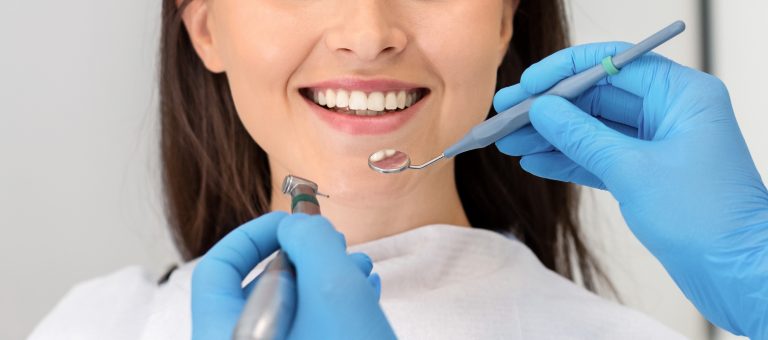How To Floss Properly?
What’s the Best Way to Floss Your Teeth?
Flossing is a crucial aspect of oral hygiene that often gets overlooked but plays a significant role in maintaining healthy teeth and gums. Knowing how to floss properly can make a substantial difference in your dental care routine. So, what is the best way to floss your teeth effectively?
Flossing: What Are The Steps To Follow?

How to floss?
Here are some steps you can take below:
- Begin by breaking off about 18 inches of dental floss and wind most of it around your middle fingers, leaving about an inch or two to work with.
- Gently glide the floss between your teeth using a back-and-forth motion, ensuring you curve it around the base of each tooth.
- Slide the floss below the gumline of each tooth to remove plaque and debris effectively.
- Use a clean section of floss for every tooth to prevent the transfer of bacteria.
- Move the floss in a C shape around each tooth to ensure thorough cleaning of the sides.
- If traditional flossing is challenging, consider using a floss holder or interdental brushes.
- Finish by rinsing your mouth with water or mouthwash to remove any loosened debris and leave your mouth feeling fresh.
What’s The Best Way To Floss With Braces?
A Special Approach
If you have braces, flossing requires a tailored approach to ensure effective cleaning and maintain optimal dental and oral health during orthodontic treatment. The presence of wires and brackets can make traditional flossing challenging, but with the right technique and tools, you can navigate around these obstacles to prevent plaque buildup and cavities. By incorporating specific steps into your flossing routine, you can keep your teeth and gums healthy throughout the process of wearing braces.
Here are some key steps below:
- Start by selecting a floss threader or orthodontic floss designed for use with braces to facilitate maneuvering around wires and brackets.
- Carefully thread the floss under the wire between two teeth, ensuring it reaches below the gumline for thorough cleaning.
- Gently move the floss back and forth between each tooth, paying special attention to cleaning around the brackets and wires to remove any debris.
- Take your time with each tooth, cleaning both sides of the tooth and the area beneath the wire to prevent plaque accumulation and maintain oral hygiene.
- Consider using an antiseptic mouthwash after flossing to further reduce bacteria and promote gum health while wearing braces.

When Should You Floss?
Timing Matters:
Ideally, you should floss at least once a day, preferably before brushing your teeth. Flossing before brushing allows you to dislodge food particles and plaque, making it easier for the toothbrush to clean effectively. Consistency is key when it comes to flossing; incorporating it into your daily routine ensures comprehensive oral care.
Types of Dental Floss
When it comes to oral hygiene, selecting the right dental floss can significantly impact the effectiveness of your cleaning routine. Understanding the differences between waxed, unwaxed, tape, and super floss can help you choose the most suitable option for your oral care regimen.
- Waxed Floss: Waxed floss is coated with a thin layer of wax, making it easier to slide between teeth, especially in tight spaces. The waxed coating helps the floss glide smoothly without shredding, making it ideal for individuals with closely spaced teeth or those new to flossing.
- Unwaxed Floss: Unwaxed floss lacks a coating and produces a squeaking sound when used, indicating that plaque and debris are being removed. This type of floss is excellent for those who prefer a more tactile indication of cleanliness and do not have tight gaps between their teeth.
- Tape Floss: Tape floss is broader and flatter than traditional floss, making it suitable for individuals with wider spaces between their teeth or dental work like bridges. The flat design of tape floss allows for comfortable cleaning in larger gaps and around dental appliances.
- Super Floss: Super floss is a multifunctional option designed for specific needs such as braces, bridges, or wide gaps between teeth. It typically consists of a stiffened end to thread under orthodontic wires and a spongy component for effective plaque removal around dental work. Super floss is durable and versatile, making it an excellent choice for individuals with unique oral care requirements.
Gain Mastery Of Flossing
Achieving mastery in the art of flossing is a cornerstone of maintaining excellent oral health. At Beautiful Dental Care, our team of dental professionals is dedicated to helping you gain expertise in flossing techniques tailored to your specific needs. By reaching out to our Gordon dental practice, you can receive personalised guidance and support to ensure that your flossing routine is optimised for maximum effectiveness.
- Personalised Guidance: Allows you to access expert advice on flossing techniques that suit your unique oral health requirements. Our dental professionals can provide custom recommendations based on factors such as the condition of your teeth, the presence of braces, or any specific concerns you may have.
- Technique Adaptation for Braces: If you are wearing braces, our team can offer specialised instructions on flossing with orthodontic appliances. Learning how to navigate around wires and brackets effectively is crucial for preventing plaque buildup and maintaining oral hygiene during orthodontic treatment.
- Consistency and Routine Maintenance: Consistency is key to reaping the full benefits of flossing. By consulting with Beautiful Dental Care, you can establish a regular flossing routine that aligns with your lifestyle and oral health goals. Our professionals can help you create a sustainable habit that promotes long-term dental wellness.
- Exploration of Floss Types: We can guide you in exploring different types of dental floss to find the most suitable option for your needs.
Our dedicated professionals are here to support you every step of the way for a brighter, healthier smile.



